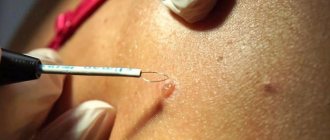Expert tested
Kuznetsova Ekaterina Olegovna Nutritionist, gastroenterologist, cosmetologist
Publication date: March 11, 2022
Review date: November 09, 2022
Radio wave removal of moles, warts and papillomas using the Surgitron device Surgitron or radioknife is a radio wave surgery device manufactured in America.
Surgitron or radio knife is used in dermatology, cosmetology, gynecology and urology. More often, the technique is used to remove warts, moles and papillomas. The device is also used for cervical erosions and for bloodless biopsy. Radioknife helps get rid of scarring after abortion and childbirth. After its use there is no pain, swelling, or infection.
The Surgitron treatment method is called radio wave surgery, radio wave coagulation or radio wave excision.
Advantages of Surgitron
Surgitron is a high-frequency device. The main advantage of such devices is the minimal traumatic effect on tissue.
The radio wave incision is performed without the physical manual pressure or crushing of tissue cells inherent in electrosurgical, pulsed, medium- and low-frequency devices, instruments made of the finest wire (a special tungsten alloy that does not heat up under the influence of radio waves), called surgical electrodes that emit high-frequency radio waves.
The specific interaction of radio waves with cells allows for careful dissection while preserving the underlying tissue. Radio waves, absorbed by intracellular fluid, affect only the superficial layers of tissue - there is no risk of damage to laterally and deeper located organs and tissues.
This is why radio wave treatment is often used on the face, cervix and genitals, especially in nulliparous women. That is, where the skin or mucous membrane is very delicate and thin, and where scar formation is undesirable.
Advantages and disadvantages of radiosurgery
Radiosurgical removal of papillomas and warts on the face and body has a wide range of advantages:
- No pain during the operation.
- There is no risk of subsequent inflammation and complications.
- Minimal recovery time, almost complete absence of restrictions.
- Tumors are removed in any place, even hard to reach.
- Performing the procedure on an outpatient basis
- It is possible to conduct histological analysis.
- The procedure is performed on an outpatient basis; there is no need to go to the hospital.
Medical clinics in Moscow offer affordable prices for the removal of papillomas and other formations using the radio wave method, which is also a significant advantage.
Disadvantages of treatment with the Fotek device:
- There is a small chance of relapse, that is, the reappearance of the formation.
- Not performed for large tumors.
How to remove moles, nevi, papillomas and other skin formations
First, the skin is treated with an antiseptic. Then local anesthesia is performed with an anesthetic (lidocaine, novocaine). The anesthetic is injected into the skin with a syringe or by applying a special anesthetic cream.
When the anesthetic has begun to take effect, the doctor takes the loop waveguide, turns on the Surgitron device and removes the formation using a radio wave.
Everything happens very quickly and painlessly. Moreover, if the neoplasm then needs to be sent for histological examination, then the mole or papilloma is removed at the root.
Kuznetsova Ekaterina Olegovna
Nutritionist, gastroenterologist, cosmetologist
You can also remove a mole or papilloma using Surgitron using smooth fractional movements, removing the formation tissue layer by layer. After such removal, virtually no traces will remain on the skin.
After removal, the wound is smoothed with a ball waveguide. In addition, tissues are coagulated to stop bleeding.
The final stage is treating the tumor removal site with an aqueous solution of chlorhexidine or fucorcin (or another antiseptic).
Indications and contraindications
Using radio waves, it is possible to remove the following tumors:
- granulomas;
- papillomas;
- warts;
- condylomas;
- telangiectasia;
- fatty hyperplasia;
- genital warts;
- molluscum contagiosum;
- keratoses - senile and seborrheic.
Contraindications:
- presence of a pacemaker;
- fever;
- herpes;
- acute infections in the body;
- cardiopulmonary failure;
- diabetes.
How is radio wave exposure performed with Surgitron in gynecology?
As with dermatological treatments, anesthesia is first performed. The doctor then removes the mass on the cervix with a loop electrode, either in one pass or, more often, in several passes.
After this, the wound is treated with a ball electrode, radio wave coagulation of the bleeding vessels is carried out and the wound on the cervix is smoothed.
At the end of the operation, the doctor treats the wound with an aqueous solution of chlorhexidine or another aqueous antiseptic.
The entire operation takes only 7-10 minutes.
Indications for removal
Many people prefer to remove a wart for aesthetic reasons. But there are other reasons for the procedure. For example, removal is carried out in cases where the formation is constantly injured by a razor, elastic bands of underwear or other items of clothing. Warts on the head can cause a lot of inconvenience during a haircut.
The radio wave method is also suitable for removing flat and plantar warts, genital warts, protruding and hanging skin growths.
Rehabilitation after radio wave exposure in gynecology
In the first day after exposure, there may be a slight nagging pain in the lower abdomen. You can take a Nurofen tablet to relieve pain.
Wound healing occurs under the fibrin film within 7-10 days. From 4-5 days, partial rejection of the fibrin film begins. From this time on, the woman may have slight bleeding from the vagina. They should not be abundant and should not have an unpleasant odor. The discharge can last up to 14-20 days, gradually decreasing.
After surgery, it is recommended to insert suppositories with antiseptics into the vagina (for example, Depantol).
After the operation, you cannot have sex, take a hot bath or go to the sauna, play sports, or do heavy physical work for a month.
Recovery period
The doctor will give several recommendations to speed up skin healing. These include the following:
- do not wet the skin area for 24 hours;
- refuse to visit the solarium, bathhouse, sauna, beach;
- wear loose clothing that does not put pressure on the wound;
- do not remove the crust that has formed on the wound;
- Do not use cosmetics or touch the wound until it has healed.
It is important to limit physical activity and stress as much as possible. If your doctor has prescribed medications, you should stick to the prescriptions. Antiseptic treatment may be required for several days; the specialist will tell you what products can be used to prevent infection of the wound.
Cost of services
| Name | Prices in rubles |
| Removal of benign skin tumors (cutaneous horn using a radio wave scalpel, for 1 unit) | 1280 |
| Removal of benign skin tumors (condylomas, papillomas, warts using a radio wave scalpel, for 1 unit) | 980 |
| Removal of benign skin tumors (neoplasms less than 5 mm in size using a radio wave scalpel) | 980 |
| Removal of benign skin tumors (neoplasms larger than 5 mm using a radio wave scalpel) | 1480 |
| Removal of benign skin tumors (condylomas, papillomas, warts up to 10 units using a radio wave scalpel, per 1 unit) | 560 |
| Removal of benign skin tumors (condylomas, papillomas, warts more than 11 to 20 units using a radio wave scalpel, per 1 unit) | 460 |
| Removal of benign skin tumors (condylomas, papillomas, warts more than 21 to 30 units using a radio wave scalpel, per 1 unit) | 360 |
| Removal of benign skin tumors (condylomas, papillomas, warts more than 30 units using a radio wave scalpel, per 1 unit) | 280 |
Complications and risk of relapse
If all instructions and recommendations of doctors are strictly followed, radio wave therapy will not cause any complications. After the procedure, there are no burns or other signs of interaction with radio waves on the affected area of tissue.
Many patients are concerned about the possibility of scar stenosis or that this method may cause deformity. In fact, with radio wave therapy, a scar does not form, since tissue damage is minimized. The risk of necrosis and scab is completely absent. This is what allows this method to be used safely even by women planning to become pregnant in the future.
As a rule, the disease does not return after this procedure. The patient should undergo a preventive examination by a specialist after six months or a maximum of a year to confirm the absence of relapse.
Postoperative recovery
After gynecological operations, the patient is prescribed a course of antibiotics. Removal of minor skin problems does not require such a prescription. The issue is resolved individually by the attending physician. Very often, local medications are prescribed - skin ointments, vaginal creams, suppositories. The patient can immediately return to work, but the operated area must be in special gentle conditions. Bandages are applied and must be changed regularly. The rehabilitation period in most cases passes without complications.
When is radio wave treatment prescribed?
Treatment of erosion using this method is relevant when it is necessary to preserve the integrity of the uterine mucosa as much as possible. Radio wave treatment is most often recommended for women and young girls. This technique is characterized by low trauma and a low risk of complications.
Also among the advantages it is worth highlighting:
- No pain during treatment;
- There is no need for general anesthesia; local anesthetics are sufficient;
- No scars after treatment;
- Preventing heavy bleeding;
- Relatively fast rehabilitation period;
- Short duration of the procedure;
- Low likelihood of complications.
Let's consider the main indications for radio wave treatment of the cervix:
- True erosion of the cervix.
- Endocervicosis, which is characterized by the proliferation of the epithelium of the inner lining of the cervical canal onto the vaginal part of the cervix.
- Cervical dysplasia.
- Radio waves are also used to remove polyps and other benign tumors.
There is a myth that radio wave therapy is only indicated for women who have given birth. However, this opinion is erroneous. After radio wave treatment there are no scars left, so this technique is suitable even for nulliparous women.
Radio wave cutting of warts in children
Radio wave therapy does not last long and does not cause discomfort or pain, so it is prescribed even to children. To refer a child for the procedure, he must undergo an initial examination and diagnosis by a dermatologist.
The patient undergoes a general analysis of urine and blood, as well as an allergy test for drugs that are part of the local anesthesia.
During the procedure, the dose of radio radiation is minimal, which is why there is no potential danger to the child’s body. Nowadays, most private clinics perform radio wave cutting of papules for young children and guarantee a positive result.
Radio waves act quickly and painlessly, do not leave scars
This is the second most popular method of combating pathological formations. The idea is to apply high-frequency current to the affected area. After treatment, new epithelium appears in this area. Radio wave technology is perfect for patients planning to give birth.
Benefits of radio wave cauterization
- no bleeding or scars;
- no pain or particular discomfort;
- healthy tissues are not affected or injured;
- no adverse reactions, excellent antimicrobial effect;
- delicate treatment that does not require anesthesia or anesthesia.
The price of radio wave exposure is 10,000 rubles. More detailed information about this type of moxibustion can be obtained during a face-to-face consultation with a gynecologist. Let us add that radio waves are a gentle option that completely preserves the structure of the muscles of the genital organs. Medicine has long and very successfully used high-frequency current in the fight against various diseases, during which time it has proven its safety.
What are warts?
Neoplasms arise due to a number of reasons: weakened immunity, stressful situations, microtrauma of the skin, non-compliance with personal hygiene rules. The result of these factors is the appearance of condylomas on the epidermis. Their localization can be anywhere - from the skin of the hands and feet, ending with the face and intimate areas.
Content:
- What are warts?
- Features of radio wave wart removal
- Indications and contraindications for the procedure
- Benefits of radio wave wart removal
- How is removal done using radio waves?
- Radio wave cutting of warts in children
- Rehabilitation period
Papules can grow throughout life and reach a diameter of 2 centimeters. The biggest danger of papillomas is that they can transform from benign to malignant. Malignant growths are called melanomas, which can still be cured in the early stages of the disease, so you should not delay a visit to the doctor.
You should not self-medicate, and take alternative medicine methods especially seriously. Celandine, acetic acid, garlic and other methods do not always save you from serious diseases, plus they can have a negative effect on the skin where the wart is located.
After a thorough examination, the specialist determines the type of tumor and prescribes a course of treatment. The most effective ways to get rid of defects on the epithelium are radio wave methods, laser technologies, cauterization with liquid nitrogen and surgical procedures.
How is removal done using radio waves?
The operation is performed using a radio wave knife that emits high-frequency waves. Radio waves act on neoplasm cells that contain fluid. The water absorbs the waves and begins to boil, as a result of which the integrity of the cell is destroyed.
When a wart ruptures, particles containing papillomavirus are released from the cells, so the room must be sterile so that the people in it do not become infected with the virus. An exhaust hood should also be installed in the room for constant air circulation.
Before the procedure begins, the patient is injected with anesthesia or a special pain-relieving ointment is applied.
The duration of the operation varies from 15 to 30 minutes (the parameters of condylomas and their number are taken into account). After heating the knife, cutting off the growth and cauterizing the tissues located nearby begins. With the help of cauterization, the manipulation is bloodless.
Features of radio wave wart removal
Radio wave therapy uses high-frequency waves emitted by a radio knife for treatment. Under the influence of these waves, the growth tissue releases heat and the process of boiling and evaporation of cells begins. This technology is considered non-traumatic and safe for the health of children, women and men.
Both the incisions and radio wave exposure are performed without destruction of tissues and blood vessels, therefore, after the recovery period, scars and cicatrices do not form on the epidermis. During radio wave removal of condylomas, sterile instruments are used, as a result of which it becomes impossible for infections and bacteria to enter the wound. After the operation, swelling and inflammation are not observed.
Trust your reproductive health to the best doctors
Whatever option is chosen, success is always based on the qualifications of the doctor and the equipment used. "El.En." offers the best conditions:
- high-class doctors with enormous experience and recognized international authority;
- technical equipment of the latest generation - we use the latest foreign devices;
- personal approach – girls and women come to us with different problems, and we always take a comprehensive approach to solving them, prescribing diagnostics to make an accurate diagnosis.
At the same time, the clinic has reasonable prices for services, for example, the cost of chemical therapy is 3,000 rubles, conservative therapy is from 1,500 rubles.
Make an appointment with a gynecologist via the website or by phone. Choose a time that is convenient for you, we are always ready to provide you with all the necessary assistance, guaranteeing the achievement of the desired result
Concept of radio wave surgery
Radio wave surgery became widespread at the end of the last century. The method was patented by an American, Dr. Irving Ellman. It was found that tissue damage is minimal when exposed to a frequency of 3.8 - 4.0 MHz. Based on this technology, the Surgitron radio wave surgical generator, which is currently being produced, was developed. Later other devices appeared (Fotek).










